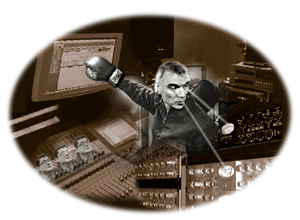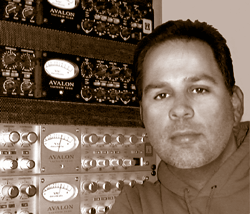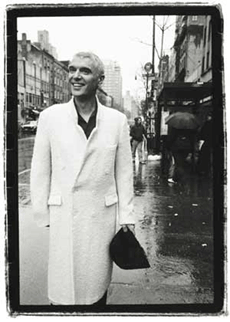|

Interview:
Recording David Byrne with Michael Mangini
|
Michael Mangini
is the owner of Mojo Music in NYC. This Grammy Award winning Producer-Engineer
recently finished recording and producing David Byrne’s latest
release “Look into the Eyeball.” Michael heavily relies
on the Vt-737sp and AD2055 EQ’s for all of his recordings
and mixes.
Q: Hi
Michael, please describe your recording setup.
A: I use Logic as my sequencing, music arrangement program and
Pro Tools I/O hardware. In my main studio I have six 888’s,
a mix plus system and four farm cards. It’s a full-blown
Pro Tools system that routes through a Sony DMX console. I have
lots of outboard gear, heavily featuring Avalon - six Vt-737sp’s,
two AD2055 EQs, as well as some other vintage outboard.
|
 |
Q:
Do you record direct to the computer or to tape first?
A: We go back and forth between recording to two inch analog tape
and direct to computer recording depending on the song and the sound.
On David Byrne’s recent album, “Look Into the Eyeball,”
we recorded most of drums to two inch tape and then dumped it into
Logic so that it could be manipulated from there. We did this to
get a warmer, punchier analog sound.
Q:
For the “Look Into the Eyeball” album, can you describe
your recording process for the songs?
A: About 80% of the David Byrne record went down like this: We
sent basic demo versions of the songs to drummer Sean Pelton and
bassist Paul Frazier. They learned the songs and came to the sessions.
I would feed a loop I had developed for the song (with David’s
input) into the live room. David on guitar plugged directly into
a Vt-737sp then into the 888, Paul on bass plugged directly into
a Vt-737sp then into the 888 and Sean on drums. They all set up
in the live room together in sort of an organic way, and they
developed their parts in that setting: learning the song, hearing
the loops, and playing along to the loops. Whiled they played,
I would hear something I liked and say, Sean that is an interesting
part but you should change it here and evolve it there. David
had ideas about everything obviously and the two of us together
would tweak what everyone was playing and get something that we
thought was cool.
|
| Once
we had all the parts worked out, we would generally take three or
four takes of each song. I would then dump all of those takes into
the computer and go through it all, picking and choosing each part
from each take. Sometimes I even chopped up parts that worked in
other sections of the song. A part that was played in the verse
might have worked in the bridge. I would go through all of the takes
and try to come up with what I thought were compelling tracks (guitar,
bass and drums). Once I had those tracks worked out, David and I
would then decide what we liked and what we wanted to change. |
|
|
Q: What
preamps and microphones did you use to record the rhythm tracks?
A: It sounds like a big plug for Avalon, but it’s true…
in the case of David’s guitar we would run it directly into
the Vt-737sp and then into Logic where we would use amp farm.
There were no amps. There were a couple of days where we rented
amps and listened to them and then decided that the way we wanted
the record to sound, amp farm suited the record better than real
amps.In most cases during the tracking David played a Gibson SG.
We would plug it directly into the 737 and use it as a preamp
and then right into the 888 and Logic where we would use amp farm.
Every guitar sound on the record is recorded that way.
We also ran the bass directly into a Vt-737sp and then straight
into Logic (via the 888) where we used either a sans amp plug-in
or sometimes just the direct bass sound. And if we wanted to overdrive
the bass we would actually overdrive the 737. A ton of Vt-737sp’s
where used on David’s guitar, the bass, and all of David’s
vocals. If you hear the record and you like the sound, you definitely
want to use the Vt-737sp.
Q: What
about drums?
A: That was a combination of things. We used Vt-737’s on
room mics and overheads as well as old outboard Neve racks. We
used different mics. A lot of times we were recording two full
drum sets at once. The drums were huge setups. The two things
that jump out about the record is that it is very drum oriented
and it also has a big orchestral aspect to it. It was a very interesting
and fun record to make.
|
|
Q: Moving
on to David’s vocal, is he difficult to record?
A: It’s hard to record David’s vocal so that it mixes
well. I will say that if you put him on an SM57 or the most expensive
C12 in the world, he still sounds exactly like David Byrne. The
difficult part is compressing and limiting his voice so that when
he is doing things like going down really low and then going up
high quickly, you get a good consistent level that still sounds
natural. He takes chances melodically when he sings - he will
go down really low with his voice in one section, then in another
section sing in false psetto. I tried to get a vocal track that
has a presence and sits well in the mix and at the same time doesn’t
become a fader riding nightmare during mixdown. A few times we
had to chain a couple compressors together to try to get a really
nice vocal so that we didn’t drive ourselves crazy when we
were trying to mix the record.
|
|
|
Q: Can
you give me a general Vt-737sp setting that you used on David’s
vocal?
A: I can actually. For David we used the High Pass Filter set
at around 55-60Hz. Generally slow attack and slow release, 4:1
compressor, boost his voice on the bottom end just a little around
15Hz, sometimes around 1.5kHz in the high mids then open it up
on the top end around 4dB at 15kHz. David has a nice warm bottom,
so you don’t have to do that much to the bottom except make
sure that it doesn’t get muddy. You really want the words
to jump and make sure his vocal has a presence in the track especially
when there is a lot of percussion banging around. I try to get
the words really present but not to the point where we have to
de-ess them.
For the most part we used the Sony C800 mic on David’s voice.
We checked approximately ten different mics and that was the one
that sounded the best by far. We tried different preamps: Neve,
G-series SSL console, but he definitely sounded the best with
the Vt-737sp and the C800. We used it on every song.
|
|
Q: During
mixdown how did you incorporate your outboard gear?
A: We used the AD2055 on the mix buss. We generally boosted a
little bit of top and a little of the bottom. Which is not uncommon.
We just wanted to warm up the bottom just a little bit where some
of the really cool stuff was going on and then way up top around
20kHz, just open that up. So one AD2055 was dedicated to the mix
buss. We would run that with some light stereo compression on
the mix buss.
The Vt-737sp’s would be in play all over the place during
mixdown. On the bass we used them, on David’s vocal we used
them. On guitars we used them. In some cases we linked two together
and use them on stereo subgroups to make the group sound more
cohesive. For example in some cases we wanted to make the strings
sound more combined. So we would group the strings coming out
of the console run them into a pair of Vt-737sp’s group compress
and EQ them, and bring them back into the console to make them
sound more like a section playing in a room rather than individual
orchestral pieces.
|
|
|
I run stereo
subgroups through the Vt-737sp this all the time; with background
vocals, drums and instrument groups.
On David’s record there might have been forty drum tracks,
so we might have to take the live drums and run them through some
sort of stereo processing, take the percussion and run that through
the same way. So the Vt-737sp is used a lot in that kind of capacity.
Whatever didn’t sound good, when we were mixing, we would
say, “run it though a 737”.
|
|
In general
I use the Vt-737sp a lot. When I’m programming in my home
studio, every single thing goes through a 737 - every track. In
my home studio I have Logic running through a Mackie Digital console
with a Digi 888. I don’t really like the way the console
sounds. So once I figure out a song in regards to programming
and sequencing, I then make it all audio. When I make it audio,
I run every track through a 737 one at a time - EQ it so it has
some snap to it, whatever it needs – make the kick more punchy
or whatever. I can really say the Vt-737sp is a great all in one
box. It has a great sounding compressor that doesn’t over
do it. It’s not like a lot of compressors out there where
you can hear it. It is subtle, yet it really does what you want
it to do. And the EQ sounds so warm and sweet - it’s not
harsh sounding at all. It’s really warm, and doesn’t
distort the instrument you are trying to EQ. If you want to open
up the top or you want to warm up the bottom, or you want to notch
out a little bit in the middle to make it bite a little bit -
It does all that but it doesn’t distort the thing you are
trying to mess with. I really love the Vt-737sp. It is truly an
amazing piece of gear. It really works for me.
Q: Thanks
for your time Michael. Would you like to make any parting comments?
A: Keep up the good work. Keep making great gear, and let me know
when you have something new, so I can go out and get it!
|

|
|
|
Michael
Mangini
Producer Mix Engineer
"What’s Going On" All Star tribute record - Britney Spears,
NSync, Michael Stipe, Destinys Child, Bono...
Producer/Remix Engineer
David Byrne LP, "Look Into the Eyeball."
Producer/Mixer
Shrek Soundtrack "Best Years of Our Lives," Grammy Nomination
Best Soundtrack, Platinum
Producer/Mixer
Bahamen "Who Let the Dogs Out" Grammy Winner - Best Dance
Recording, Triple Platinum
Producer/Mixer
Otown "Love Should Be a Crime" Platinum
Producer/Mixer
Best of Busta Rhymes "Various Tracks"
Engineer/Mixer/Programmer
Bruce Hornsby "Spirit Trail"
Producer
The
Corrs "What Can I Do"
(Multi-platinum) Producer /remixer
Digable
Planets LP "Reachin" (Gold)
Co-Producer/Mixer/Programmer
Other artists worked with include:
Joan Osborne, Donna Summer, Dido, Beastie Boys, Jodeci, Run DMC, Paula
Abdul, and Shawn Colvin.
|

